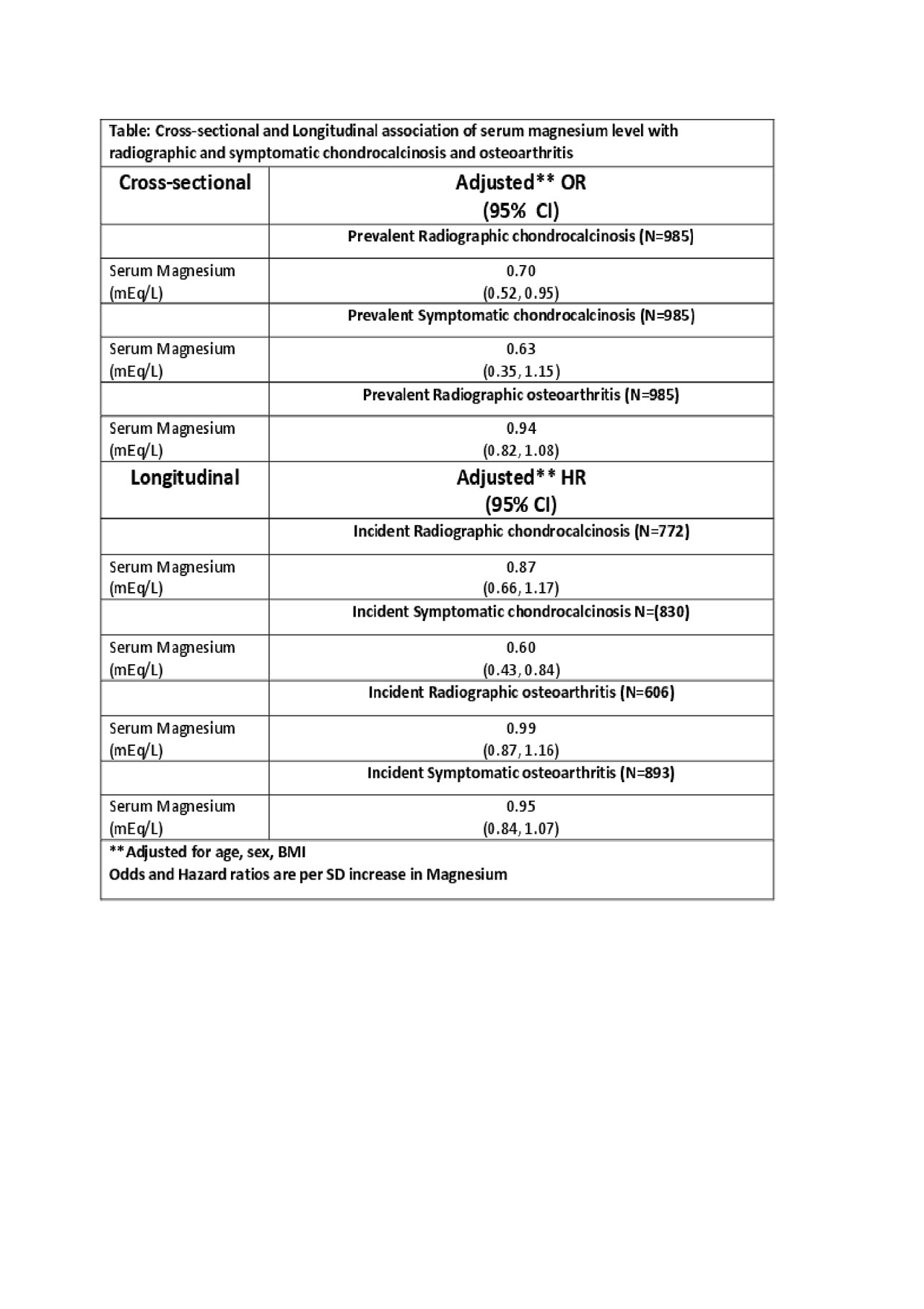Session Information
Session Type: ARP Abstract Session
Session Time: 2:30PM-4:00PM
Background/Purpose: High serum magnesium (Mg) may have anti-inflammatory effects and prevents the release of extracellular pyrophosphate, inhibiting CPP deposition. Cross-sectional data has linked low serum Mg levels with radiographic chondrocalcinosis (CC) but there is a paucity of longitudinal studies and an absence of studies of symptomatic CC. Since osteoarthritis (OA) and CC often co-exist and have other common risk factors, we evaluated the relation of serum Mg levels to prevalence and risk of 4 outcomes, radiographic CC, symptomatic CC, radiographic knee OA, and symptomatic knee OA in a large cohort of community dwelling older adults.
Methods: For each of the 4 outcomes we performed a nested case-control study within the Multicenter Osteoarthritis (MOST) study, a NIH-funded longitudinal cohort of persons with or at risk of knee OA. Serum Mg level (mEq/L) was measured (AU480, Beckman Coulter Inc., Brea CA 92821) at baseline. For each outcome, we excluded those who, at baseline had the outcome. Our outcomes from baseline through 60 month follow-up were incident (new onset) radiographic OA (KL-grade ≥2 in either or both knees), symptomatic OA (radiographic OA with frequent knee pain in the same knee), radiographic CC (presence of CC in either or both knees) and symptomatic CC (radiographic CC with frequent knee pain in the same knee). To examine cross sectional baseline associations for each outcome, we took subjects selected for Mg assessment for the other outcomes and evaluated the association of serum Mg (per SD increase) to prevalent radiographic OA, radiographic and symptomatic CC using logistic regression. Using each case control sample, we then examined the longitudinal association of baseline serum Mg to incident radiographic OA, symptomatic OA, radiographic and symptomatic CC using Cox proportional hazards regression. All analyses were adjusted for age, sex, and BMI.
Results: Among 985 participants (mean age 62 yrs, 59% women and mean BMI 29.9 kg/, mean Mg levels 1.89 mEq/L) , the prevalence was 324 radiographic OA, 47 radiographic CC and 11 symptomatic CC. In cross-sectional analyses (see table), serum Mg was not associated with prevalence of radiographic OA (per standard deviation of Mg, OR=0.94, 95% CI 0.82, 1.08) but was modestly associated with radiographic CC (OR=0.70, 95% CI 0.52, 0.95) and symptomatic CC (OR= 0.63, 95% CI 0.35, 1.15).
Incidence of radiographic OA occurred in 250 of 606 persons; 336 of 893 had incident symptomatic OA; 46 of 772 had incident radiographic CC; 33 of 830 had incident symptomatic CC. In longitudinal analyses, higher baseline serum Mg levels were not associated with risk of incident radiographic OA (HR=0.99, 95% CI 0.87, 1.16), symptomatic OA (HR 0.95, 95% CI 0.84, 1.07) or radiographic CC (HR=0.87, 95%CI 0.66, 1.17) but were associated with risk of symptomatic CC (HR= 0.60, 95% CI 0.43, 0.84).
Conclusion: Higher serum magnesium levels were associated with a lower risk of symptomatic CC but not with radiographic CC, radiographic OA, or symptomatic OA. The association of Mg with incident symptomatic CC has important clinical implications and is consistent with cross sectional studies but is based on small numbers and needs replication.
To cite this abstract in AMA style:
Misra D, Sun X, Nevitt M, Lewis B, Torner J, Neogi T, Lichtenstein A, Matthan N, Felson D. The Association of Serum Magnesium with Chondrocalcinosis and Osteoarthritis [abstract]. Arthritis Rheumatol. 2019; 71 (suppl 10). https://acrabstracts.org/abstract/the-association-of-serum-magnesium-with-chondrocalcinosis-and-osteoarthritis/. Accessed .« Back to 2019 ACR/ARP Annual Meeting
ACR Meeting Abstracts - https://acrabstracts.org/abstract/the-association-of-serum-magnesium-with-chondrocalcinosis-and-osteoarthritis/

